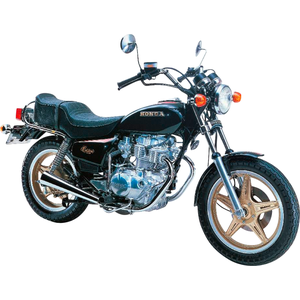Honda CM400T [1979-1984]: A Timeless Middleweight for the Practical Rider
Introduction
The Honda CM400T occupies a unique space in motorcycling history. Introduced in 1979, this air-cooled parallel twin bridged the gap between utilitarian commuters and weekend pleasure machines. Over its six-year production run, it became a favorite for riders who valued simplicity, reliability, and approachable performance. Even decades later, the CM400T remains a compelling choice for urban commuters, café racer builders, and vintage enthusiasts alike. Let’s explore why this unassuming Honda continues to charm riders.
Design & Styling
The CM400T’s design leans into the “standard” motorcycle ethos of the late ’70s—neutral ergonomics, a teardrop fuel tank, and a chrome-accented exhaust system. Its 184 kg (406 lbs) wet weight feels manageable, with a seat height hovering around 780 mm (30.7 inches), making it accessible for shorter riders. The swept-back handlebars encourage an upright riding position, ideal for city traffic or casual weekend rides.
Honda’s attention to practicality shines in details like the dual-piston front disc brake (a rarity in its class at the time) and the minimalist instrumentation. The analog speedometer and fuel gauge are legible but refreshingly uncluttered compared to modern digital clusters. While the chrome fenders and side covers exude retro charm, they’re also straightforward to maintain or customize—a boon for DIY enthusiasts.
Engine & Performance
At its heart lies a 395 cc SOHC parallel-twin engine, producing 44 PS (32 kW) at 9,000 RPM. These numbers might seem modest today, but the CM400T’s power delivery is where it excels. The engine thrives in the mid-range, with a linear torque curve that makes it forgiving for new riders yet engaging enough for seasoned hands. Throttle response is crisp, thanks to its twin carburetors (tuned to 2 turns out on the air screw), and the exhaust note has a muted, rhythmic thrum that’s pleasantly nostalgic.
Acceleration is adequate rather than thrilling: 0–60 mph (0–97 km/h) takes around 6.5 seconds, with a top speed of approximately 155 km/h (96 mph). Where this engine truly shines is in real-world usability. The air-cooled design eliminates radiator maintenance worries, and the 9.6-liter (2.5-gallon) fuel tank delivers a range of 200–250 km (124–155 miles), depending on riding style.
Handling & Ride Experience
The CM400T’s tubular steel frame and 33 mm telescopic fork (preloaded with 140 ml of SAE 10W oil) strike a balance between agility and stability. At low speeds, the bike feels nimble, slicing through traffic with ease. The rear twin shocks, adjustable for preload, handle bumps competently, though rough roads can feel jarring by modern standards.
Tire pressure recommendations—2.0 BAR (29 PSI) front and rear—hint at its urban focus. The Bridgestone Trail Wing-style tires of the era provide decent grip for dry conditions but can feel vague in the rain. Braking is confident for a bike of this era, with the front disc offering progressive bite, though the rear drum requires a firm press.
Competition
The CM400T faced stiff competition in the early ’80s middleweight segment:
- Yamaha XS400: Yamaha’s parallel twin rival emphasized sportier styling and a slightly higher-revving engine. However, the XS400’s chain-driven OHC required more frequent valve adjustments compared to the CM400T’s simpler SOHC setup.
- Suzuki GS450: With 47 PS, the GS450 offered more power and a six-speed transmission. Yet its higher maintenance complexity (including shim-adjusted valves) made the Honda a favorite for budget-conscious riders.
- Kawasaki KZ440: Kawasaki’s entry prioritized cruising comfort with a lower seat height. The KZ440’s shaft drive reduced maintenance but added weight, making the CM400T feel livelier in corners.
Where the Honda stood out was in its balance. It wasn’t the fastest, lightest, or most technologically advanced, but its blend of reliability, ease of maintenance, and neutral ergonomics made it a versatile all-rounder.
Maintenance
The CM400T’s mechanical simplicity is a DIY enthusiast’s dream. Here are key considerations:
Valve Adjustments
- Intake: 0.10 mm (0.004 in) cold
- Exhaust: 0.14 mm (0.006 in) cold
Stick to these clearances to prevent ticking or performance loss. MOTOPARTS.store stocks shim kits for precise adjustments.
Oil Changes
- Without filter: 2.7 liters (2.85 quarts) of SAE 10W-40
- With filter: 3.0 liters (3.17 quarts)
Regular changes every 4,800 km (3,000 miles) keep the parallel twin happy.
Carburetor Tuning
The stock 2.0 turns out on the air screw provides a stable idle at 1,200 ± 100 RPM. For aftermarket exhausts or air filters, consider upgrading to our Mikuni VM30 carburetor kits for smoother throttle response.
Electrical System
The NGK DR8ES (standard) or DR8EIX (iridium) spark plugs, gapped to 0.7 mm (0.028 in), are critical for consistent cold starts.
Chain & Sprockets
The 16/35 tooth sprocket combo and 102-link chain strike a balance between acceleration and highway cruising. Upgrade to a DID 525VX3 chain for extended lifespan.
Conclusion
The Honda CM400T isn’t about cutting-edge specs or blistering speed—it’s about riding joy distilled to its essentials. Its air-cooled engine, forgiving ergonomics, and timeless styling make it a canvas for customization or a trusty daily companion. While newer bikes offer more power or tech, few match the CM400T’s blend of character and practicality.
Whether you’re restoring a barn find or tweaking a café racer, MOTOPARTS.store has the OEM-spec parts and performance upgrades to keep your CM400T running smoothly for another 40 years. From NGK spark plugs to premium brake fluids, we’ve got your back—because classics deserve modern reliability.



















